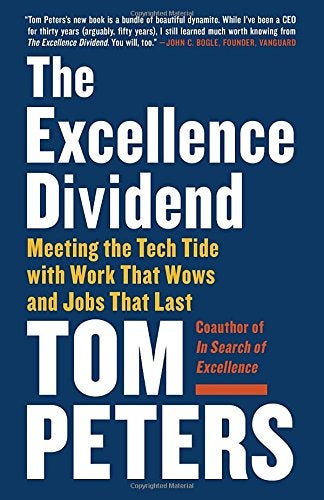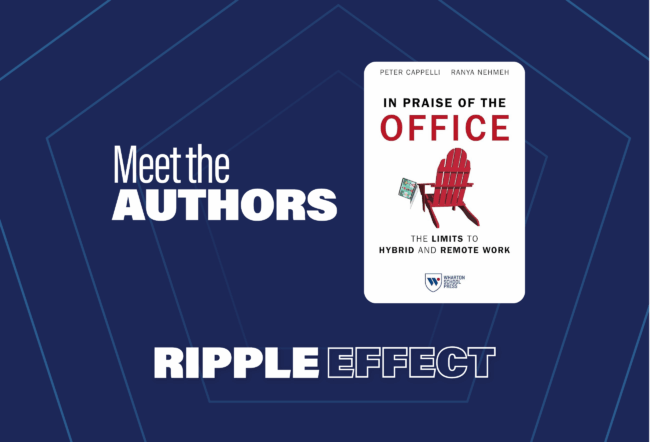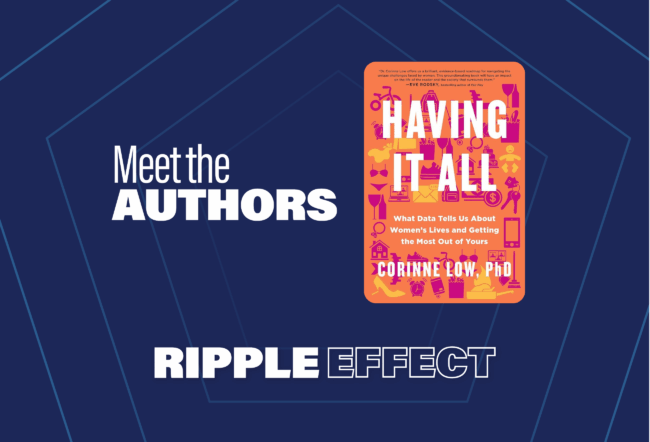 Back in 1982 when Tom Peters co-authored the best-selling book In Search of Excellence, U.S. corporations faced high unemployment and interest rates. Today, Peters sees different challenges to success. He says training is “investment number one,” for example, but thinks its importance is much under-appreciated. He also believes that a culture of caring can be a powerful prerequisite for winning, yet many companies don’t get it. He further faults marketers for focusing on millennials while ignoring the far more affluent over-50 crowd. Now Peters is back with his 18th book, titled The Excellence Dividend: Meeting the Tech Tide with Work That Wows and Jobs That Last. He shared insights from it on the Knowledge at Wharton show on SiriusXM channel 111. (Listen to the full podcast using the player at the top of this page.)
Back in 1982 when Tom Peters co-authored the best-selling book In Search of Excellence, U.S. corporations faced high unemployment and interest rates. Today, Peters sees different challenges to success. He says training is “investment number one,” for example, but thinks its importance is much under-appreciated. He also believes that a culture of caring can be a powerful prerequisite for winning, yet many companies don’t get it. He further faults marketers for focusing on millennials while ignoring the far more affluent over-50 crowd. Now Peters is back with his 18th book, titled The Excellence Dividend: Meeting the Tech Tide with Work That Wows and Jobs That Last. He shared insights from it on the Knowledge at Wharton show on SiriusXM channel 111. (Listen to the full podcast using the player at the top of this page.)
Following is an edited transcript of the conversation.
Knowledge at Wharton: Today, every business and worker seems to want to find excellence. But with all the technology like AI (artificial intelligence), it seems the search for excellence is shifting.
Tom Peters: First of all, I completely acknowledge and support maximum investment in technology. I am in no way, shape or form against that. I don’t know what happens 30 years from now. But let’s step back a half step. Incredibly smart people are saying that AI will take over as many as 50% of our jobs – including the lawyers and the doctors – within the next 10 to 20 years. There are people who have equally high IQs who are saying it’s more like 25 to 35 or 40 years. So, smart people have wildly varying estimates of what’s going on.
On the flip side of that, my bias is – especially for, say, anybody under the age of 40 who has a quarter of a century in the workforce left to go – that if you are not preparing yourself for a very different world and not doing that today, you’re nuts.
The second half of the story [relates to] fabulous baseball announcers. I grew up in Baltimore. We had a [sportscaster] by the name of Ernie Harwell, whom I was in love with. What you did as an announcer is to engage your audience. You didn’t tell them about [just] a baseball game. A computer could tell them about a baseball game. AI could tell them about a baseball game. But you engaged them. You made my mother-in-law, who listened to the Boston Red Sox on the radio, every inning for 25 years, feel that she was part of the thing.
“[If you are] under the age of 40 … [and] you are not preparing yourself for a very different world … you’re nuts.”
I had a bad experience in a retail store last week. I wanted to buy books. I had an armful of books with me. And the checkout lines were insanely long. I didn’t lose my cool, which I would have 15 years ago. But I said, “Come on, you guys are under total threat by Amazon.”
I love coming into a bookstore and finding things that I didn’t expect to get. But your only possibility of differentiating yourself is to have short lines. Clerks that smile. Clerks that are excited to take me back to the American History section and show me something cool that came in.
With that kind of setting, I can differentiate a bookstore for the next 10 to 15 to 20 years. I think if I’m just going for efficiency, and I’m fighting with Amazon, and my lines are 27 people long at not-Christmas time, then I’m a cooked goose.
Knowledge at Wharton: How important are the people going to be for businesses, whether they are the employees or the customers? There’s this belief that we’re going to have technology taking over and running so much of what our businesses are.
Peters: It’s [almost] 2020 – I don’t know what the answer is in 2050. But whether you’re my age, your age, or somebody 25, we have to get from now to then. And the world is not going to turn upside-down in the next 10 years. For a human being, a decade-long block is pretty significant. And so, how are we going to differentiate ourselves?
My bias is people are 10 times more important because the way they will stay in business is to intimately differentiate their product or service, whether it be a radio broadcast of a baseball game, an in-flight experience or what have you. So, my answer is: [People will be] far more important than ever, if they are well-trained, well-led, [and] if they are engaged in what they’re doing.
Knowledge at Wharton: It seems like companies aren’t willing to give the time to do the training to prepare their employees for the job. They want them custom-ready, ready to roll, to be able to hit the ground running. That wasn’t always necessarily the case, especially when we had a relatively bigger reliance on manufacturing.
Peters: An exceptional service employee can do at least as much, or more, as an exceptional manufacturing employee could do. All I can say at some level relative to what you suggested is I could not be in greater disagreement.
It is more important than ever to train people. If we go back to 2008 – and this is not pure technology – the financial crash comes. The number of people in the stores goes way down. Stupid companies like Circuit City fired all their best salespeople to get their average costs down. And yet, the Container Store – which was voted a few years ago as the No. 1 company to work for in America — doubled their training budget in the pits of the financial crisis. Because they said, “Look, even in the pits of the crisis, 70% of the [former] number of people are going to come in…. And we want them to fall in love. And we want to sell them twice as much.”
The “If you train them, they’ll leave” idea is [wrong]. In the book – and I haven’t done this in any of my 17 books before – I have a separate section on training. I call training “investment number one.” I believe it entirely. Differentiation is always possible – in a six-person organization, or in a 60,000-person organization.
“I single out listening as the single-most significant trait that a leader can have.”
One thing I do want to say: The heart of the American-Japanese-British-Canadian-Sri Lankan economy is not the giant firms. It is the SMEs; the so-called small and middle-sized enterprises…. If I’m part of the management guru set – and I despise the term – we have focused exclusively on the Fortune 500. And the Fortune 500, domestically in the U.S., employs less than 10% of us.
Knowledge at Wharton: How has leadership changed from the first time you did a book in this area until now?
Peters: I would argue – and this is contrarian – that most leadership has not changed. A broadcaster on the radio, a person running a small business, or a salesperson at Oracle makes the sale and keeps the sale and makes the repeat sale based on relationships, relationships, relationships. And relationships take time.
Years ago I worked with a high-end systems salesperson at AT&T. I remember him saying to me, “Tom, the top salesmen pay no attention whatsoever to the shifting incentive schemes. The top salesmen know that they make their money over time based on fabulous customer relationships. And they invest in those relationships like maniacs. It may not pay off when there’s a little tweak to the incentive system for the next quarter. But over the one-year, two-year, certainly five-year period of time, it is the winning hand.”
I believe it’s true with bosses and their employees, with vendors and with customers. The quality of the relationship is the number-one thing.
My leadership chapter has a shockingly sophisticated title – “Some Stuff.” No vision, no transformation, no disruption. It’s just things you can do to be a better leader. Again, in the leadership section, I single out listening as the single-most significant trait that a leader can have.
Knowledge at Wharton: You also talk about culture in the book. In the last decade or so, there’s more emphasis on the culture of a company. You see more companies wanting to have teams come together for projects. HR departments are focused on this: When they’re hiring somebody, [they may] have the skills, the background and that great resume, but are they a fit for the company?
Peters: Absolutely. It amuses me, because when we did the work for In Search of Excellence, I was working for McKinsey & Company. We started talking about culture in 1980. The number of people who tried to get me fired for using words like that are too numerous to mention.
But the culture word has become a lot more front-and-center than it has been in the past. There are two things I would say. Number one, culture is not an HR issue. It’s a CEO issue – every minute, every day, forever and ever, amen.
I tell a little story about boarding a Southwest Airlines plane in Albany, New York, for a flight down to Washington. The pilot came late; the prior flight had gotten in late. [There was] incredible pressure to get off on time. [You had] the standard thing – half dozen wheelchairs sitting at the front of the jet way. The pilot, under pressure, nonetheless stops, turns to the woman in the first wheelchair, and says, “Would you mind if I took you down the jet way?” This is [one of] those little things that stick.
“Women buy virtually everything. [Yet] most organizations still are at the level – particularly in the senior ranks – of 5%, 10% or 15% women. That is stupid.”
It is the first time I have ever seen a pilot do that. Why does it happen? It happens in part – or to a significant degree – because the hiring criteria at Southwest Airlines is enumerated by former president Colleen Barrett (now president emerita and corporate secretary at the company). She says, “We hire for listening, caring, smiling, saying ‘thank you’ and being warm.” And then she goes on and says, “And that holds for pilots and mechanics as much as it holds for the people who are at the desk, or the flight attendants.” So, yes, it is that kind of a culture fit that’s terribly important.
There’s another person who I quote in the book, who runs a middle-sized pharmaceutical company – another place that’s not known for sweetness and light. He says, “We only hire nice people…. I interview the smartest microbiologist in the world. I am dying to have his talent, her talent, on my team.” But, he said, “Unless they are nice and decent people who can work with others, I won’t hire them.”
He puts them through what he calls “the gauntlet,” where they have to have short interviews with 15 people, from the finance department, to the receptionist, to what-have-you. Any of the 15 people can blackball Mr. God-with-a-Microbiology-Degree. His one-liner – which isn’t original, but which is powerful – is, “One rotten apple can spoil the cultural barrel.”
A great friend of mine, who’s a publisher at Forbes – Rich Karlgaard – wrote a book about two or three years ago called The Soft Edge. His argument was that these soft forces are the mid- to long-term differentiators. A culture of arrogance and true “believerdom-ship” is what’s getting Facebook in trouble.
Knowledge at Wharton: One of the chapters in the book talks about added value. In terms of the idea of added value, what’s the most important thing that still isn’t being done today?
Peters: The last of the value-added strategy says “fabulous people.” [Consider] the two largest markets on earth that are underserved. One of them is women. Women buy virtually everything – 80%S of consumer goods. Over 50% of commercial goods. [Yet] most organizations still are at the level – particularly in the senior ranks – of 5%, 10% or 15% women. That is stupid.
The other market is even bigger. I’m an old guy. I’m the one you should be focusing on. What’s the definition of a millennial? A human being who has no money. What is the definition of old people? The people who have the money. My throwaway line is, “My people” – meaning old people – “my people don’t have the money. We have all the money.” And the amount of effort and attention that goes into marketing and product development for the over-50s is pathetically low.
Some people say it’s because of the American Way. We honor and love youth. There’s some truth to that. But the average marketing department, or the average social media department probably has an age of 28-and-a-half, and at the most, 31-and-a-half. Arguably, 28-and-a-half-year-olds are not the best people to develop marketing campaigns or products for people who are 50 or 60 years old. I mean, we are a goldmine.



